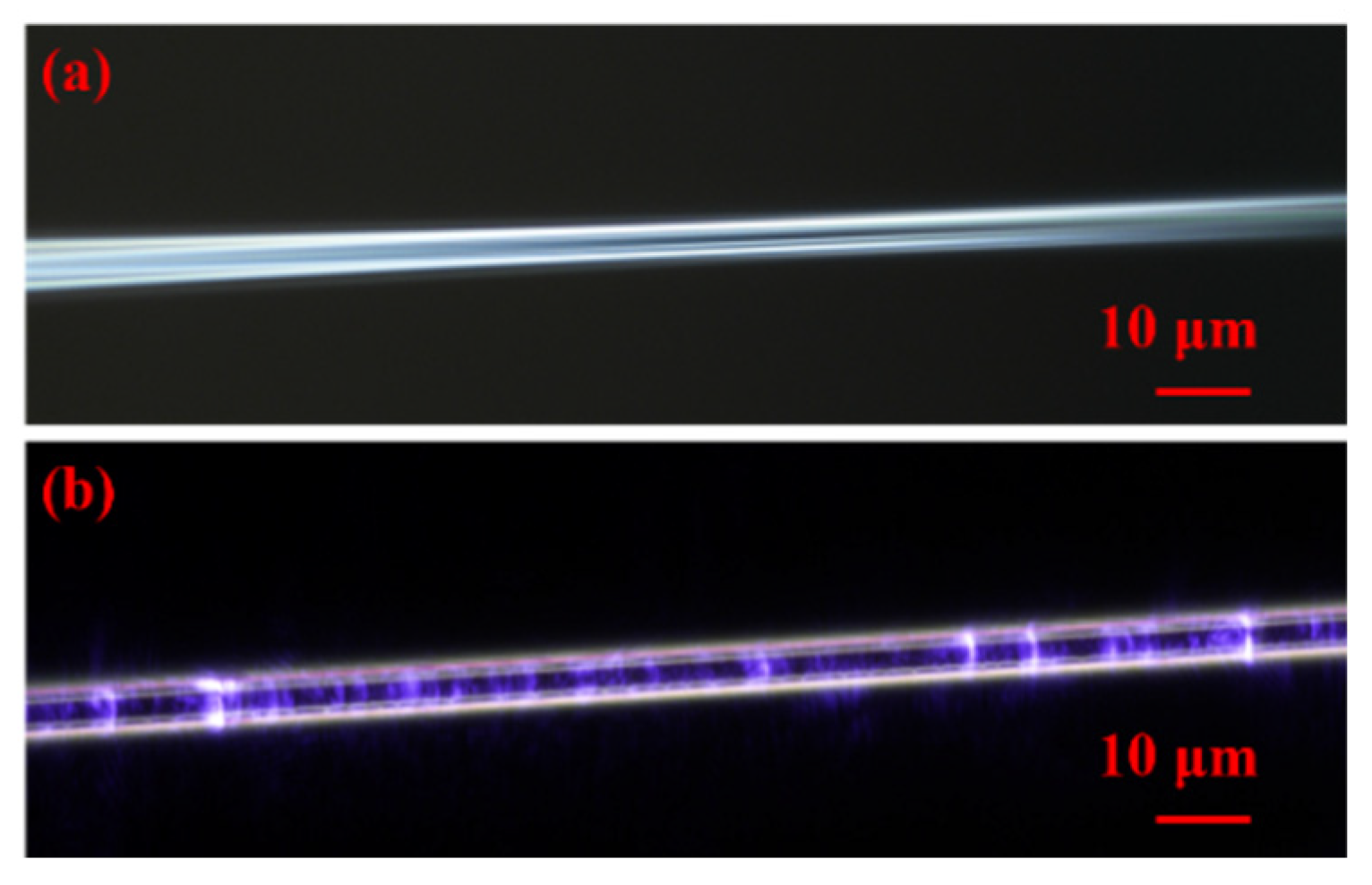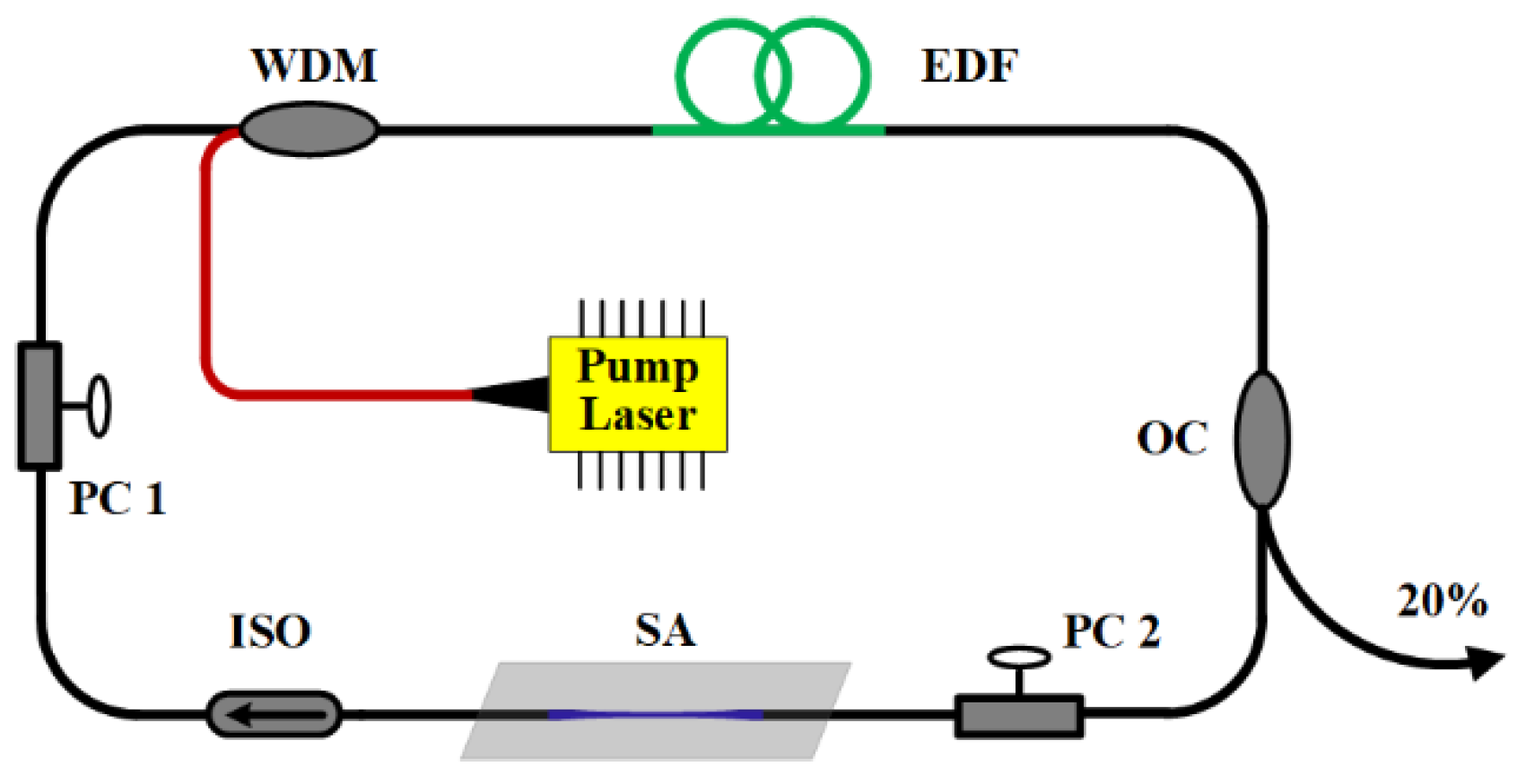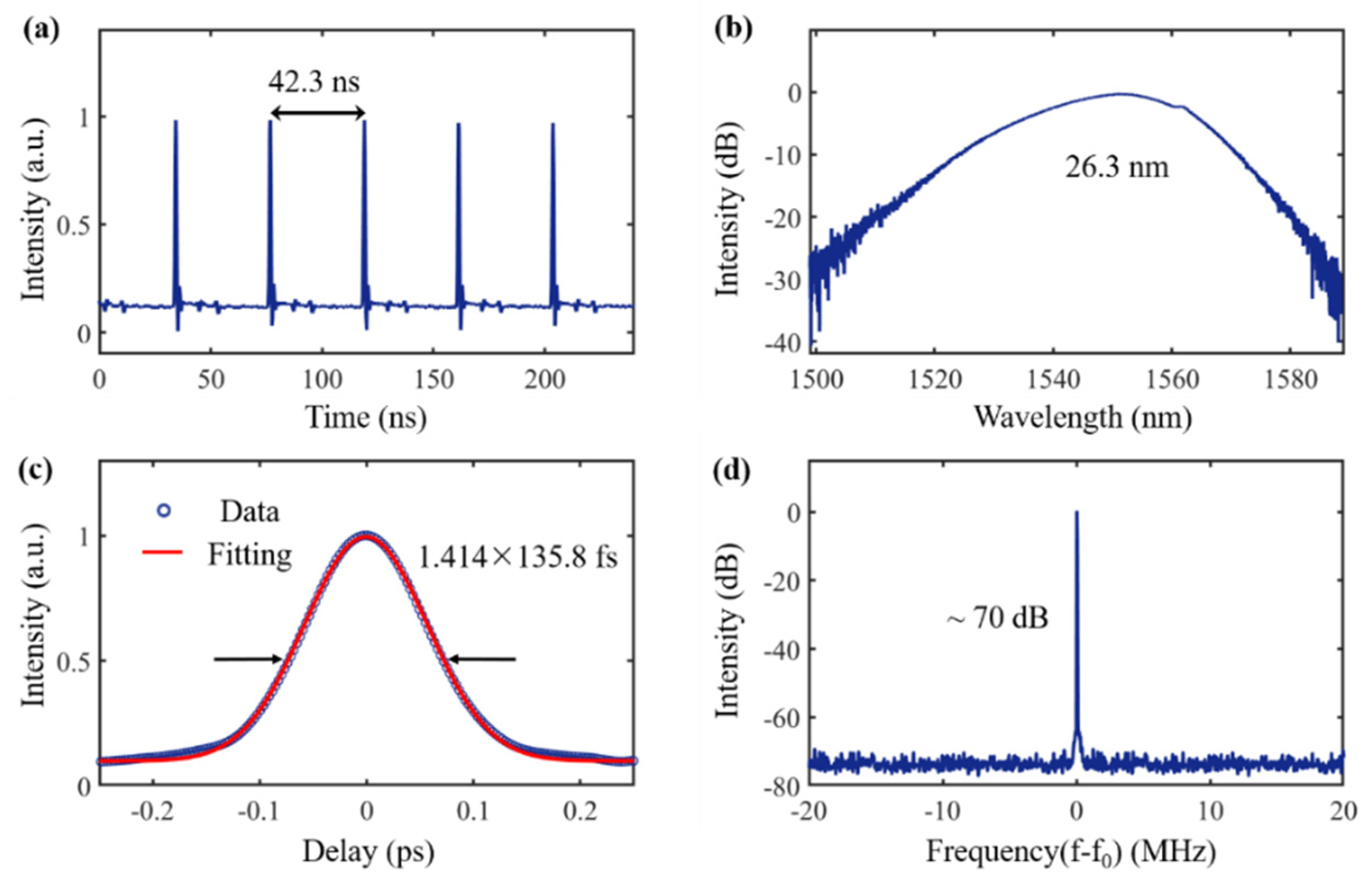Femtosecond Pulsed Fiber Laser Based on Graphdiyne-Modified Tapered Fiber
Abstract
:1. Introduction
2. Material Characterization and Device Fabrication
2.1. Material
2.2. Devices
3. Experimental Setup and Results
4. Discussion
5. Conclusions
Author Contributions
Funding
Conflicts of Interest
References
- Nishizawa, N. Ultrashort pulse fiber lasers and their applications. Jpn. J. Appl. Phys. 2014, 53, 090101. [Google Scholar] [CrossRef]
- Sun, Z.P.; Martinez, A.; Wang, F. Optical modulators with 2D layered materials. Nat. Photonics 2016, 10, 227–238. [Google Scholar] [CrossRef] [Green Version]
- Wang, F. Two-dimensional materials for ultrafast lasers. Chin. Phys. B 2017, 26, 034202. [Google Scholar] [CrossRef]
- Woodward, R.I.; Kelleher, E.J.R. 2D Saturable Absorbers for Fibre Lasers. Appl. Sci. 2015, 5, 1440–1456. [Google Scholar] [CrossRef] [Green Version]
- Bao, Q.L.; Zhang, H.; Wang, Y.; Ni, Z.H.; Yan, Y.L.; Shen, Z.X.; Loh, K.P.; Tang, D.Y. Atomic-Layer Graphene as a Saturable Absorber for Ultrafast Pulsed Lasers. Adv. Funct. Mater. 2009, 19, 3077–3083. [Google Scholar] [CrossRef]
- Fu, B.; Hua, Y.; Xiao, X.S.; Zhu, H.W.; Sun, Z.P.; Yang, C.X. Broadband Graphene Saturable Absorber for Pulsed Fiber Lasers at 1, 1.5, and 2 µm. IEEE J. Sel. Top. Quantum Electron. 2014, 20, 5. [Google Scholar] [CrossRef]
- Sotor, J.; Pasternak, I.; Krajewska, A.; Strupinski, W.; Sobon, G. Sub-90 fs a stretched-pulse mode-locked fiber laser based on a graphene saturable absorber. Opt. Express 2015, 23, 27503–27508. [Google Scholar] [CrossRef]
- Lee, J.; Koo, J.; Lee, J.; Jhon, Y.M.; Lee, J.H. All-fiberized, femtosecond laser at 1912 nm using a bulk-like MoSe2 saturable absorber. Opt. Mater. Express 2017, 7, 2968–2979. [Google Scholar] [CrossRef]
- Ahmad, H.; Ramli, R.; Yusoff, N.; Samion, M.Z.; Ismail, M.F.; Bayang, L.; Aidit, S.N.; Zamzuri, A.K.; Thambiratnam, K. 155 nm-wideband and tunable q-switched fiber laser using an MXene Ti(3)C(2)T(X)coated microfiber based saturable absorber. Laser Phys. Lett. 2020, 17, 11. [Google Scholar] [CrossRef]
- Huang, W.; Ma, C.; Li, C.; Zhang, Y.; Hu, L.; Chen, T.; Tang, Y.; Ju, J.; Zhang, H. Highly stable MXene (V2CTx)-based harmonic pulse generation. Nanophotonics 2020, 9, 2577–2585. [Google Scholar] [CrossRef]
- Zhang, M.; Wu, Q.; Zhang, F.; Chen, L.; Jin, X.; Hu, Y.; Zheng, Z.; Zhang, H. 2D Black Phosphorus Saturable Absorbers for Ultrafast Photonics. Adv. Opt. Mater. 2018, 7, 1800224. [Google Scholar] [CrossRef] [Green Version]
- Huang, W.; Hu, L.; Tang, Y.; Xie, Z.; Zhang, H. Recent Advances in Functional 2D MXene-Based Nanostructures for Next-Generation Devices. Adv. Funct. Mater. 2020, 30, 2005223. [Google Scholar] [CrossRef]
- Huang, W.; Wang, M.; Hu, L.; Wang, C.; Xie, Z.; Zhang, H. Recent Advances in Semiconducting Monoelemental Selenium Nanostructures for Device Applications. Adv. Funct. Mater. 2020, 30, 2003301. [Google Scholar] [CrossRef]
- Huang, W.; Zhu, J.; Wang, M.; Hu, L.; Tang, Y.; Shu, Y.; Xie, Z.; Zhang, H. Emerging Mono-Elemental Bismuth Nanostructures: Controlled Synthesis and Their Versatile Applications. Adv. Funct. Mater. 2021, 31, 202007584. [Google Scholar] [CrossRef]
- Wu, Q.; Chen, S.; Guan, L.; Wu, H. Highly Sensitive Photothermal Fiber Sensor Based on MXene Device and Vernier Effect. Nanomaterials 2022, 12, 766. [Google Scholar] [CrossRef]
- Wu, L.; Dong, Y.; Zhao, J.; Ma, D.; Huang, W.; Zhang, Y.; Wang, Y.; Jiang, X.; Xiang, Y.; Li, J.; et al. Kerr Nonlinearity in 2D Graphdiyne for Passive Photonic Diodes. Adv. Mater. 2019, 31, 1807981. [Google Scholar] [CrossRef]
- Huang, C.; Li, Y.; Wang, N.; Xue, Y.; Zuo, Z.; Liu, H.; Li, Y. Progress in Research into 2D Graphdiyne-Based Materials. Chem. Rev. 2018, 118, 7744–7803. [Google Scholar] [CrossRef]
- Li, G.; Li, Y.; Liu, H.; Guo, Y.; Li, Y.; Zhu, D. Architecture of graphdiyne nanoscale films. Chem. Commun. 2010, 46, 3256–3258. [Google Scholar] [CrossRef]
- Ivanovskii, A.L. Graphynes and graphdyines. Prog. Solid State Chem. 2013, 41, 1–19. [Google Scholar] [CrossRef]
- Liang, H.; Lin, F.F.; Zhang, Z.J.; Liu, B.W.; Jiang, S.H.; Yuan, Q.P.; Liu, J.W. Multicopper Laccase Mimicking Nanozymes with Nucleotides as Ligands. ACS Appl. Mater. Interfaces 2017, 9, 1352–1360. [Google Scholar] [CrossRef]
- Guo, J.; Wang, Z.; Shi, R.; Zhang, Y.; He, Z.; Gao, L.; Wang, R.; Shu, Y.; Ma, C.; Ge, Y.; et al. Graphdiyne as a Promising Mid-Infrared Nonlinear Optical Material for Ultrafast Photonics. Adv. Opt. Mater. 2020, 8, 2000067. [Google Scholar] [CrossRef]
- Wu, Q.; Jin, X.; Chen, S.; Jiang, X.; Hu, Y.; Jiang, Q.; Wu, L.; Li, J.; Zheng, Z.; Zhang, M.; et al. MXene-based saturable absorber for femtosecond mode-locked fiber lasers. Opt. Express 2019, 27, 10159–10170. [Google Scholar] [CrossRef] [PubMed]
- Yu, Z.H.; Wang, Y.G.; Zhang, X.; Dong, X.Z.; Tian, J.R.; Song, Y.R. A 66 fs highly stable single wall carbon nanotube mode locked fiber laser. Laser Phys. 2013, 24, 015105. [Google Scholar] [CrossRef]
- Lin, Y.H.; Lin, S.F.; Chi, Y.C.; Wu, C.L.; Cheng, C.H.; Tseng, W.H.; He, J.H.; Wu, C.I.; Lee, C.K.; Lin, G.R. Using n- and p-Type Bi2Te3 Topological Insulator Nanoparticles to Enable Controlled Femtosecond Mode-Locking of Fiber Lasers. ACS Photonics 2015, 2, 481–490. [Google Scholar] [CrossRef]
- Jin, X.X.; Hu, G.H.; Zhang, M.; Hu, Y.W.; Albrow-Owen, T.; Howe, R.C.T.; Wu, T.C.; Wu, Q.; Zheng, Z.; Hasan, T. 102 fs pulse generation from a long-term stable, inkjet-printed black phosphorus-mode-locked fiber laser. Opt. Express 2018, 26, 12506–12513. [Google Scholar] [CrossRef]





Publisher’s Note: MDPI stays neutral with regard to jurisdictional claims in published maps and institutional affiliations. |
© 2022 by the authors. Licensee MDPI, Basel, Switzerland. This article is an open access article distributed under the terms and conditions of the Creative Commons Attribution (CC BY) license (https://creativecommons.org/licenses/by/4.0/).
Share and Cite
Wu, Q.; Chen, S.; Bao, W.; Wu, H. Femtosecond Pulsed Fiber Laser Based on Graphdiyne-Modified Tapered Fiber. Nanomaterials 2022, 12, 2050. https://doi.org/10.3390/nano12122050
Wu Q, Chen S, Bao W, Wu H. Femtosecond Pulsed Fiber Laser Based on Graphdiyne-Modified Tapered Fiber. Nanomaterials. 2022; 12(12):2050. https://doi.org/10.3390/nano12122050
Chicago/Turabian StyleWu, Qing, Si Chen, Wenli Bao, and Haibin Wu. 2022. "Femtosecond Pulsed Fiber Laser Based on Graphdiyne-Modified Tapered Fiber" Nanomaterials 12, no. 12: 2050. https://doi.org/10.3390/nano12122050
APA StyleWu, Q., Chen, S., Bao, W., & Wu, H. (2022). Femtosecond Pulsed Fiber Laser Based on Graphdiyne-Modified Tapered Fiber. Nanomaterials, 12(12), 2050. https://doi.org/10.3390/nano12122050







